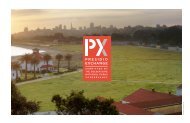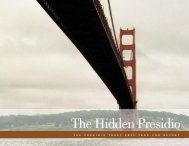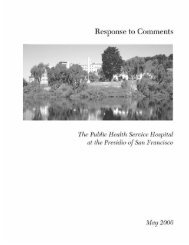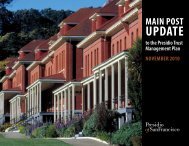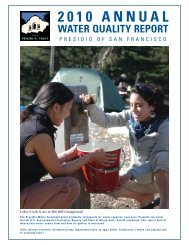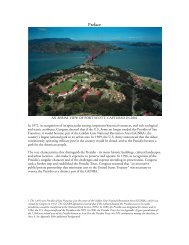Presidio Chapel Historic Structure Report - Presidio Trust
Presidio Chapel Historic Structure Report - Presidio Trust
Presidio Chapel Historic Structure Report - Presidio Trust
- No tags were found...
You also want an ePaper? Increase the reach of your titles
YUMPU automatically turns print PDFs into web optimized ePapers that Google loves.
HISTORIC STRUCTURE REPORTFINALSTAINED GLASS RECOMMENDATIONS *Existing ConditionsThe stained glass windows of the main chapel are approaching the end of thelife cycle of the connective materials. All of the windows exhibit problemsranging from out-of-plane portions to severe buckling, and several windows arein failure with severe buckling and deterioration of metals. There is very little, ifany, broken glass, but this is a real threat with such severe warping and bending.Over time, the materials of leaded glass windows are naturally susceptible todeterioration that affects structural integrity, waterproofing capacity, and thequality of light transmission. Among the causes of window deterioration areoxidation, wind pressures, gravity loads, and airborne particulates.Oxidation of the lead and soldered joints weaken the structural integrity ofsupports for the glass pieces. Over time, a layer of oxidized material developson the surface of the metals due to continued atmospheric exposure. Since the<strong>Presidio</strong> is located in a marine environment, additional corrosion of the metalsmay be caused by airborne salts.Varying wind pressures cause flexing of the panels, which leads to fatigue of thelead, joints, and connections to supports. The flexing and oxidation combine todeteriorate the cementious water-caulking material, thus opening pathways forwater infiltration to the interior and adversely affecting the frames, structure andfinishes of the chapel.The structural integrity of the windows is affected by gravity loads on lead, apliable metal that, although supported, stretches and bends over time.Environmental airborne particulates collect on the exterior surfaces, and residuesfrom oil and wax fumes accumulate on the interior surfaces. These accumulatedmaterials greatly reduce the amount and quality of light coming into the chapeland may cause the exterior surface to become pitted over an extended period oftime. Lower light volume and quality can make the art content of the windowsdifficult to distinguish, and the colors may be perceived as dull.Currently there is no known vandalism to the windows. Unexpected openingsfrom vandalism may weaken the surrounding connections, create a direct pathfor water, and make neighboring windows difficult to see due to adjacent brightareas. Some urban churches install transparent plastic shields outside stained glasswindows to prevent damage from vandalism.RecommendationsIt should be a priority to have the windows releaded, grouted and cleaned inthe next ten years. The most severely deteriorated windows should be restoredimmediately. This could prevent breaking of glass, material damage to thestructure and finishes of the building, and diminution of the chapel’s aesthetics.Most of the windows will require restoration by the end of this decade due toincreasing fragility.If financially feasible, it would be most efficient to restore all the windows atonce when the general contractor’s scaffolding and site protection are in place.Restoration at this time would also take advantage of on-site constructionpersonnel who would have the skills and materials available to address anyhidden building fabric issues that may be revealed during the removal of thewindows. Additionally, with the building expansion and the addition of a suite ofnew windows, presenting the stained glass windows as unifying elements of thebuilding would contribute to a successful project.Restoration should be undertaken before a majority of the windows begin tosignificantly fail. Restoration work should include documentation of existingconditions, removal of panels to a stained glass studio for cleaning, installationof temporary infill panels of glass or other weatherproof materials, releading,grouting, and preparation for reinstallation. Panels should be reinstalled inoriginal locations, securely attached to the building structure and installed to bewaterproof.An opinion verbally delivered by Reflections Studios in 1999 stated thatthe windows should be releaded within 20 years. This report supports thatrecommendation.124MARCH 2012



